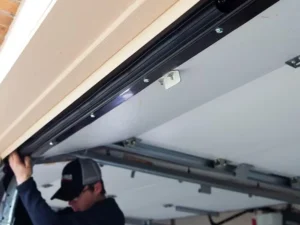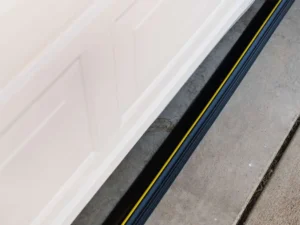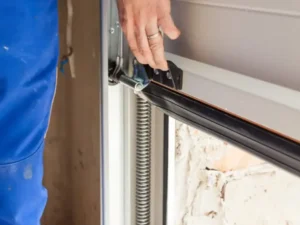A garage is an important place in our house. Here, we store our vehicles, essential tools, and repair tool kits. So, it is necessary to maintain the garage’s correct indoor climate. You know, the biggest opening in the garage is the door. It would be best if you used a garage door seal to seal it. It shields the interior space of your garage from all sorts of natural calamities.
There is a wide range of garage door types. Consecutively, there are diverse types of garage door seals. This is the main subject of our today’s article.
What Is a Garage Door Seal?

A garage door seal is an integral part of protecting a garage. It protects against outdoor elements and makes the interior safer and more energy efficient.
According to the definition, a garage door seal is a barrier that keeps outside elements out. It protects the interior from moisture, debris, pests, and drafts into the garage area through the gaps around the door’s perimeter. The materials used for making a garage weather stripping can be different. Each material offers unique advantages. Here are some popular materials used in garage door weather stripping manufacturing.
- Rubber: Commonly used for bottom seals due to flexibility & durability
- Vinyl: Offers good resistance to weather elements and is easy to install
- Neoprene: Known for its excellent sealing properties and resistance to oils
- EPDM: Provides good weather resistance & durability.
- Other materials are PVC, brush, foam, aluminum, and steel.
Garage door weather stripping offers numerous advantages. These benefits make this particular product popular in a wide range of applications.
- The garage weather stripping helps keep the garage at a steady temperature. It lowers the cost of energy.
- It protects the garage from rain, snow, wind, and extreme temperatures.
- The garage weather stripping blocks entry for insects, rodents, and other pests.
- It minimizes outdoor noise infiltration. The garage and house are quieter and more peaceful because of it.
- It prevents debris accumulation.
Garage Door Seal Types

Different types of garage door seals are available for various reasons. First, garage doors come in various styles and materials. For the perfect fit, different types of garage door seals come in. Second, seals are crucial to withstand different weather conditions. Thus, a diverse range of garage door weather stripping is available.
Third, homeowners may have preferences for certain seal materials. There are other reasons as well. Based on the application’s popularity, we have divided garage door weather stripping types into the following categories.
Garage Door Bottom Seal
A garage door bottom seal is a type of weatherproofing component. When closed, it seals the gap between the door’s bottom and the floor. Its primary purpose is to block air, dirt, bugs, and water from entering the garage.
The garage door lower seal also helps to protect the garage and its items from water damage during rainy seasons. There are different kinds of garage door bottom seals. Most people prefer the bulb type, the beading type, the J-type, and the T-type. Each of these types has its own perks and ways of being installed.
Bulb Type Garage Door Bottom Seal
A bulb-type garage door bottom seal features a bulb-shaped sealing mechanism. Its design ensures it fits perfectly into the garage door’s bottom edge.
You may often find bulb seals on garage doors of both homes and businesses. They improve insulation and weatherproofing. This type differs from others because of how it is built and how easily it can be compressed. Because its shape is like a bulb, so it fits tighter.
Baded Type Garage Door Bottom Seal
The Beaded-Type Garage Door Bottom Seal is a common variant. It is also prevalent in sealing the bottom edge of garage doors. It features a series of beads or ridges along its length and interlocks with corresponding tracks or channels on the bottom of the garage door.
What sets them apart is their effective barrier against external elements. The beaded design ensures a tight seal, even on irregular surfaces.
J-Type Garage Door Bottom Seal
A J-type garage door bottom seal is a specific type of weather stripping. It features flexible rubber or vinyl materials shaped like the letter “J.” It has one side attached to the bottom of the garage door. The other side forms a seal against the ground.
This seal is widely popular in residential and commercial garage doors. Its unique J-shape design allows for effective sealing and accommodates variations in floor level and door movement.
T-Type Garage Door Bottom Seal
A T-type garage door bottom seal is a type of weatherstripping. It is suitable for sealing the garage door bottom and the floor tightly. It features a T-shaped design that inserts into a specially designed groove on the bottom of the garage door.
This seal is primarily used on sectional garage doors. What makes it unique is its effective barrier against various elements. It provides easy installation and enhanced protection.
Garage Threshold Seal
A garage threshold seal is a durable rubber or vinyl barrier at the bottom of a garage door opening. It primarily blocks out drafts, debris, insects, and water from entering the garage beneath the door.
Other types of seals are attached directly to the bottom of the door. But this type is installed directly onto the garage floor. This unique placement ensures a tight seal, even on uneven surfaces.
Brush Seal
Another common type of garage door weatherstripping is the garage brush seal. It has flexible nylon or polypropylene brushes.
Rigid seals work best on smooth surfaces. On the other hand, garage door brush covers work best on areas that aren’t level. Because of this, these weather stripping are great for garage floors that aren’t level.
Doorstop Weatherstripping
A doorstop weatherstripping is a special kind of garage weather stripping. It is placed along the sides and top of the garage door frame where it meets the walls. Its main job is to make a tight lock when the door is shut and keep outside elements out.
Unlike bottom or threshold seals, doorstop weatherstripping targets the parameters. Its unique design uses a stretchy material that ensures it fits well and keeps you warm.
Panel Weatherstripping
Garage panel weatherstripping is a particular type of garage door weatherstripping. Its primary purpose is to make a tight seal between panels. Like other garage door weatherstripping, it keeps drafts, wetness, and trash out of the garage.
The unique thing about panel weatherstripping is that it is made to fit perfectly in the spaces between panels. This type is different because it focuses on sealing the bottom or sides of the door.
Reverse Angle Seal
Another kind of garage weather stripping is a reverse-angle garage door seal. This type differs from others because it is attached to the door frame. Along the side and top of the door, this uncommon location helps keep outside factors from getting into the garage.
What Is the Best Way to Seal a Garage Door?

The best way to seal a garage door involves a systematic approach. All you have to do is follow the proper steps, usually the five steps below.
Assessment & preparation
First, check the condition of the garage door seal. Identify any areas of leakage or damage. Measure the dimensions of the garage weather stripping and prepare sufficient tools for removal and installation. Note that this step is essential to ensure accurate replacement.
Removal
Carefully remove the old seals from the garage door. Remember to do it cautiously to avoid damaging the door or surrounding structures. Use appropriate tools (pliers or a pry bar) to detach the seals from the fixtures gently.
Installation
Choose the appropriate garage door seal based on climate, door type, and budget. Install the new seals according to manufacturer instructions. Do you know why this is necessary? It ensures optimal fit along the side of the garage door.
Final adjustment
After installation, make any necessary adjustments. This may involve trimming excess material or adjusting the positioning of the seals. Careful adjustments are required to ensure optimal coverage.
Maintenance
Regularly check the garage door seals for signs of damage. Periodically clean them to get rid of dirt or other things that are stuck on them. Replace seals on a garage door if necessary.
Frequently Asked Questions
Q1. How Do I Know What Garage Door Bottom Seal I Need?
Answer: To find the proper garage door bottom seal, consider the weather, the type of door (metal or wood), and the seal material. If your chosen product meets your needs, it will work well and last long.
Q2. How Do I Know If My Garage Door Seal Is Bad?
Answer: The garage weather stripping may get damaged, such as wear and tear, cracks, or brittleness. Also, think about these things if you notice wind, water getting in, or louder noises. You should immediately repair the garage door lock if you see any of these signs.
Q3. Are There Different Size Garage Door Seals?
Answer: Most types of garage doors come with standard sizes. There are but ways to make it fit doors of different sizes. These choices guarantee a good fit and cover against weather and pests.
